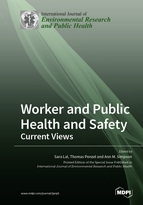Worker and Public Health and Safety: Current Views
A special issue of International Journal of Environmental Research and Public Health (ISSN 1660-4601). This special issue belongs to the section "Occupational Safety and Health".
Deadline for manuscript submissions: closed (30 April 2019) | Viewed by 218619
Special Issue Editors
Interests: smart health technology and sensors and wearables; health carers; electrophysiology; heart rate variability; cardiovascular research; bllod pressure and hypertension, diabetes; medical sensors and algorithms; mental health (anxiety, depression, PTSD, mood, perception); neurosciences and cognitive decline and function; memory and attention; fatigue/drowsiness/sleepiness; human performance and attention; worker safety; transport; eye activity and image analysis; counterterrorism; technologies of the future; education; law and ethics
Interests: sleep medicine; sleep disorders; medical informatics; neurotelemedicine; biomedical signal processing and medical device development
Special Issue Information
Dear Colleagues,
Health and safety in the workforce and general public domains continue to be crucial areas of concern for our ever-advancing technological and demanding society. Disease epidemics and public threats continue to rise. As we progress in the 21st century, worker and public health and safety concerns continue to escalate in many areas, including medical, transportation, security, defence, and other industries and services. Fatigue and sleepiness, diabetes and metabolic disorders, cardiovascular diseases, mental disorders, cognitive decline, cancer, musculoskeletal disorders, and the list is inclusive, are a few of many major health issues; and also adds to the socio-economic burden. For example, fatigue and sleep disorders are of major concern in transport, military, aviation, cleaning, mining, security and medical sectors. Additionally, shift workers have added vulnerability to multiple chronic diseases. The monotonous and demanding nature of many work environment are also linked to excessive sleepiness, stress, cognitive decline, cardiovascular diseases, diabetes, etc., which contribute to detrimental human health, errors and accidents. The probability of these hazards increase rapidly over consecutive work hours; which can be catastrophic for the worker who may also be responsible for the safety of others. Further, the cleaning and security industries, are also burdened with musculoskeletal disorder, pain and other societal diseases. Moreover, environmental factors such as, heat, noise and pollutants, also affect health and safety. This Special Issue is targeted at research and reviews addressing all aspects of “Worker and Public Health and Safety: Current Opinion and Research”. We invite submissions widely, from all fields of worker and public health and safety, of original and experimental manuscripts and reviews, including systematic reviews, case reports and commentaries. Topics, with respect to all areas of worker and general public health and safety, may include, but are not restricted to, sleepiness/fatigue, ageing-related cognitive disorders; chronic diseases, such as diabetes and other metabolic disorders, cancer, cardiovascular and musculoskeletal diseases and mental disorders and stress; biomarkers for early detection of chronic diseases/health issues; environmental factors, noise and pollutants; security and counter-terrorism; ethics, economy, costs and compensation linked to societal diseases and errors and accidents; as well as safety measures, bio/technology and countermeasures to improve health and safety.
by Chief Guest Editor: Assoc. Prof. Sara Lal
Assoc. Prof. Sara Lal
Prof. Thomas Penzel
Prof. Ann Simpson
Guest Editors
Manuscript Submission Information
Manuscripts should be submitted online at www.mdpi.com by registering and logging in to this website. Once you are registered, click here to go to the submission form. Manuscripts can be submitted until the deadline. All submissions that pass pre-check are peer-reviewed. Accepted papers will be published continuously in the journal (as soon as accepted) and will be listed together on the special issue website. Research articles, review articles as well as short communications are invited. For planned papers, a title and short abstract (about 100 words) can be sent to the Editorial Office for announcement on this website.
Submitted manuscripts should not have been published previously, nor be under consideration for publication elsewhere (except conference proceedings papers). All manuscripts are thoroughly refereed through a single-blind peer-review process. A guide for authors and other relevant information for submission of manuscripts is available on the Instructions for Authors page. International Journal of Environmental Research and Public Health is an international peer-reviewed open access monthly journal published by MDPI.
Please visit the Instructions for Authors page before submitting a manuscript. The Article Processing Charge (APC) for publication in this open access journal is 2500 CHF (Swiss Francs). Submitted papers should be well formatted and use good English. Authors may use MDPI's English editing service prior to publication or during author revisions.
Keywords
- fatigue and sleepiness
- sleep disorders
- cardiovascular disease
- diabetes
- health and safety
- mental and cognitive disorders
- musculoskeletal disorders
- environmental factors
- counter-terrorism and security
- work errors
- accidents and costs








